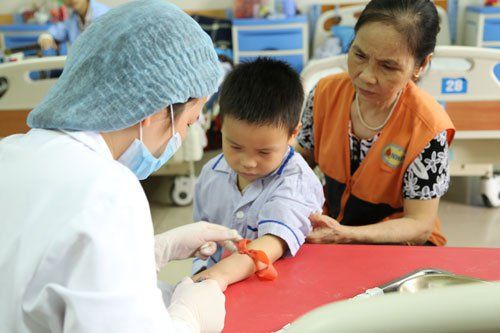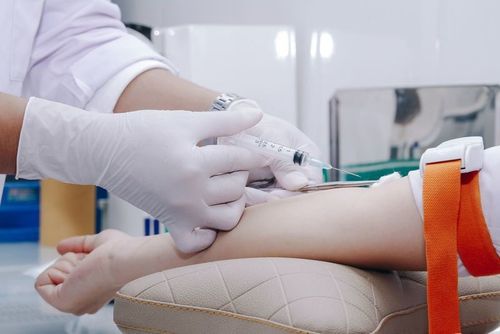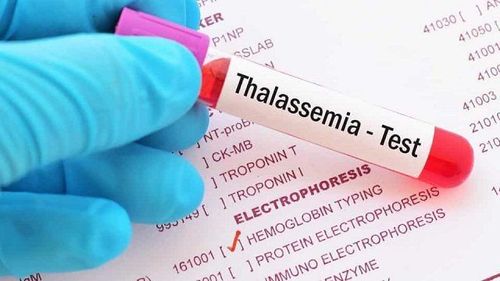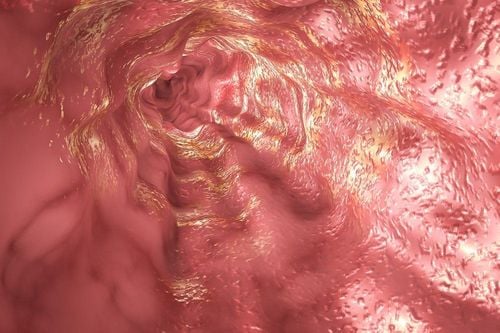This is an automatically translated article.
Thalassemia is one of the most common genetic abnormalities in the world. The disease causes anemia because red blood cells break more easily than normal. The detection of disease or carrier of the disease is important in preventing the risk of severe disease for the next generation.
1. What is Thalassemia?
Thalassemia anemia is also known as Mediterranean anemia or anemia. This is a group of inherited diseases caused by a defect in hemoglobin (Hb) synthesis.
Normally hemoglobin is synthesized by two alpha globin chains and two beta globin chains, but in this disease a defect in the gene that synthesizes at least one of these two chains causes the disease. People divide thalassemia into two main types including:
Alpha thalassemia: Disease caused by the loss of at least one or more alpha chain-producing genes. The disease is especially common in people of Africa, the Mediterranean or Southeast Asia. Beta-thalassemia: A condition in which the production of beta-chain is reduced due to a mutation or loss of the gene that regulates the beta-chain, leading to difficulty in the production of Hb A. The disease is more common in the Mediterranean, Middle Eastern, and regional populations. Southeast Asia, or India. Both alpha and beta forms can be found in all subjects, regardless of gender, and are divided into 3 levels of severity, moderate and mild. This usually depends on the extent of the loss of the gene that regulates the alpha or beta chain. With each level of disease, there are different measures of care, treatment and prognosis.

Bệnh thiếu máu thalassemia hay còn được gọi là bệnh thiếu hay thiếu máu địa trung hải
2. What are the symptoms of thalassemia?
Depending on the severity of the disease, patients with congenital hemolytic anemia have different manifestations, including:
2.1.Severity Many cases show severe severity, which means that the child dies at an early age. mother's belly. If the baby is born, often has severe anemia. This condition can appear from soon after birth, usually manifests most clearly when the baby is 4 to 6 months old and the severity gets worse. With manifestations such as:
Pale child, yellow skin and sclera; Often retarded in physical and mental development; There may be fever, diarrhea or other digestive disorders. With adequate detection and blood transfusion, a child can develop normally until about 10 years of age. After the child is 10 years old, the child shows complications due to erythrocyte proliferation and iron stagnation such as: large skull, apical tumor, forehead tumor, high cheekbones, flat nose, protruding maxillary teeth, osteoporosis makes children very susceptible to fractures; Dull skin, yellow sclera; Gallstones; Delayed puberty with female symptoms up to 15 years of age without menses...; Physical retardation. Beyond the age of 20, people with this serious disease often have more complications of heart failure, arrhythmia, diabetes, cirrhosis... seriously reducing life expectancy.
2.2. Moderate level Anemia usually appears later than severe disease, usually when the disease is between 4 and 6 years old, the child needs a blood transfusion. Children may show signs of anemia such as:
Fatigue, rapid breathing, dizziness, headache. Yellow skin and sclera. Tired children may be less flexible than other children. If not treated properly and early, the patient will also have complications such as hepatosplenomegaly, gallstones... In middle age, there will also be complications such as diabetes, heart failure, cirrhosis of the liver. . Where children are detected and treated appropriately, complications can be reduced and development is relatively normal. 2.3. Mild level For those with mild disease, they are called hemolytic gene carriers. These people may not show any abnormality at all. The body develops normally, however, anemia will be detected when the need is increased such as when blood loss, pregnancy, infection...

Trẻ mệt mỏi, kém linh hoạt hơn các trẻ khác có thể là triệu chứng bệnh thiếu máu thalassemia
3. Is thalassemic anemia dangerous?
This congenital anemia is very dangerous, especially for people with severe disease. The disease seriously reduces life expectancy in severe patients, for average people, although treatment measures can maintain the patient's life expectancy, lifelong disease treatment must be accepted. People with the disease, if they have to have a lot of blood transfusions, are at risk of complications due to excess iron in the body such as cirrhosis of the liver caused by iron infection...
For those who carry the gene or mild form, usually do not need treatment and often develop develop normally. But it also affects the next generation if not pre-marital screening. Because if a carrier of the gene marries a carrier or has a disease, the risk of having a baby with a serious disease is high.
Thus, this is a serious genetic disease that affects the health and psychology of the patient and can also affect the next generations.
4. How to diagnose and treat thalassemia
4.1 How to diagnose thalassemia In addition to the clinical manifestations of anemia, to diagnose the disease, it is necessary to perform a number of paraclinical tests including:
Blood test: The number of red blood cells can be seen. normal or increased, hemoglobin decreased, red blood cells hypochromic. Iron test: Seeing increased iron in the blood, ferritin (stored iron) increased. Hemoglobin electrophoresis: This is a diagnostic method, seeing a change in the percentage of hemoglobin. Gene testing: For people with alpha-type disease, genetic testing is often required to identify the disease. 4.2 How to treat thalassemia Treatment depends on the type of disease. For people with mild disease, there is usually no need for special treatment. As for people with severe and moderate disease, they can be treated with measures such as:
Blood transfusion: Red blood cell transfusion when the hemoglobin level is below 7g/dl after 2 tests without any other cause, or >7g/dl with signs of bone deformity. Iron chelation: Treat iron overload with injection or oral medication. Iron chelation should be initiated when the serum ferritin index is greater than 1000 ng/ml, usually starting after a transfusion of about 20 units of erythrocyte sedimentation. Chelation therapy should be lifelong. Splenectomy: Only when blood transfusion is less effective to reduce red blood cell destruction or the spleen is too large to cause pain to the patient. Hematopoietic stem cell transplant, also known as marrow transplant: Applied to patients with severe disease and conditions to be able to have a marrow transplant. This is the most advanced method currently in the treatment of hemolytic anemia and can cure the disease.

Xét nghiệm máu để chẩn đoán bệnh thiếu máu thalassemia
5. Notes when suffering from thalassemia
Some notes when patients have congenital hemolytic disease include:
In severe and moderate cases, the treatment needs to take place for life, the patient should be examined and treated periodically at specialized facilities. department. People with thalassemia during pregnancy need to be very careful. Pre-marital counseling is needed to avoid the risk of the child being born with severe hemolytic disease, affecting the child's health and psychology. If two people carry the same disease gene, there is a 25% chance of having a child with a severe disease, a 50% chance of carrying the gene, and a 25% chance of being healthy. Therefore, if you intend to become pregnant, you should be consulted carefully and do prenatal screening at 12 to 16 weeks of age.
Patients should have a nutritious and balanced diet with components such as glucid, protid, lipid, vitamins and minerals that will help keep the body healthy. Avoid infections because these people have low resistance and when the body's demand increases, it will produce more abnormal red blood cells. Avoid infection by always maintaining good hygiene, exercising regularly and in accordance with your health situation, keeping your body warm when it's cold, avoiding or limiting contact with people who are sick. risk of infection, ensuring food safety ... Vaccination against diseases such as influenza, measles, Rubella, encephalitis, pneumonia, hepatitis B, hepatitis A is especially necessary for those splenectomy patient. Some drugs can be used under the doctor's prescription such as: taking folic acid to increase red blood cell production, calcium, zinc and vitamin D supplements should be added. Avoid iron overload in the body: Do not self-administer iron-containing drugs, should limit foods containing high iron content such as beef, dark green vegetables. To reduce iron absorption by the body, drink fresh tea every day right after eating. In case the patient, especially the severe and moderate form, and the splenectomy patient, if he has fever, fatigue or symptoms of an infection, should seek medical attention early for prompt treatment. Because the risk of infection is often more severe in people with this disease. Here are some basic facts to know about thalassemia. It is important that not everyone can recognize their disease early, especially for those with mild form. Sometimes only an increased need is detected during pregnancy, trauma causes blood loss...so early detection of the disease should be carried out screening, especially pre-marital screening is very important in preventing children from contracting the disease. disease in the next generation. Should go to medical facilities to conduct disease screening, especially at the time of deciding to become pregnant and give birth.
To prepare for a healthy pregnancy, both husband and wife should have their reproductive health checked 3-5 months before becoming pregnant.
The wife should:
Get vaccinated before pregnancy (especially against rubella because rubella in pregnancy is extremely dangerous ) Genetic testing to screen for genetic diseases before pregnancy Check for secondary infections In particular, women over 35 years old who want to become pregnant (especially if they have never been pregnant) will have to have a very detailed health check because pregnancy at this age often problems: Ovarian failure, premature birth, higher risk of birth defects, placenta previa, preeclampsia. Husbands should:
Check reproductive health, detect diseases of testicular atrophy, physiological weakness, weak sperm... Sexually transmitted diseases, especially those that cannot be cured, are extremely dangerous. Vinmec currently has many comprehensive health care programs for couples, pregnant mothers and their unborn babies, including basic pre-marital examination packages, advanced pre-marital examination packages, and maternity packages. . Vinmec has a team of experienced doctors in the fields of obstetrics and gynecology, IVF, stem cells, gene technology, capable of synchronously and comprehensively deploying the most advanced assisted reproductive techniques today.
Please dial HOTLINE for more information or register for an appointment HERE. Download MyVinmec app to make appointments faster and to manage your bookings easily.













